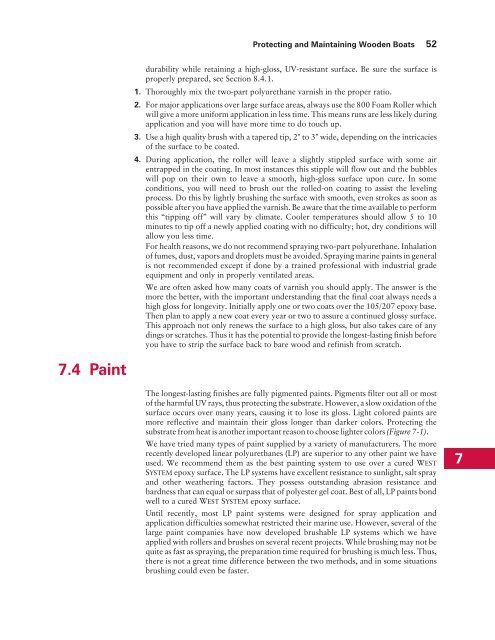Wooden Boat Restoration Repair - WEST SYSTEM Epoxy
Wooden Boat Restoration Repair - WEST SYSTEM Epoxy
Wooden Boat Restoration Repair - WEST SYSTEM Epoxy
Create successful ePaper yourself
Turn your PDF publications into a flip-book with our unique Google optimized e-Paper software.
7.4 Paint<br />
Protecting and Maintaining <strong>Wooden</strong> <strong>Boat</strong>s 52<br />
durability while retaining a high-gloss, UV-resistant surface. Be sure the surface is<br />
properly prepared, see Section 8.4.1.<br />
1. Thoroughly mix the two-part polyurethane varnish in the proper ratio.<br />
2. For major applications over large surface areas, always use the 800 Foam Roller which<br />
will give a more uniform application in less time. This means runs are less likely during<br />
application and you will have more time to do touch up.<br />
3. Use a high quality brush with a tapered tip, 2" to 3" wide, depending on the intricacies<br />
of the surface to be coated.<br />
4. During application, the roller will leave a slightly stippled surface with some air<br />
entrapped in the coating. In most instances this stipple will flow out and the bubbles<br />
will pop on their own to leave a smooth, high-gloss surface upon cure. In some<br />
conditions, you will need to brush out the rolled-on coating to assist the leveling<br />
process. Do this by lightly brushing the surface with smooth, even strokes as soon as<br />
possible after you have applied the varnish. Be aware that the time available to perform<br />
this “tipping off” will vary by climate. Cooler temperatures should allow 5 to 10<br />
minutes to tip off a newly applied coating with no difficulty; hot, dry conditions will<br />
allow you less time.<br />
For health reasons, we do not recommend spraying two-part polyurethane. Inhalation<br />
of fumes, dust, vapors and droplets must be avoided. Spraying marine paints in general<br />
is not recommended except if done by a trained professional with industrial grade<br />
equipment and only in properly ventilated areas.<br />
We are often asked how many coats of varnish you should apply. The answer is the<br />
more the better, with the important understanding that the final coat always needs a<br />
high gloss for longevity. Initially apply one or two coats over the 105/207 epoxy base.<br />
Then plan to apply a new coat every year or two to assure a continued glossy surface.<br />
This approach not only renews the surface to a high gloss, but also takes care of any<br />
dings or scratches. Thus it has the potential to provide the longest-lasting finish before<br />
you have to strip the surface back to bare wood and refinish from scratch.<br />
The longest-lasting finishes are fully pigmented paints. Pigments filter out all or most<br />
of the harmful UV rays, thus protecting the substrate. However, a slow oxidation of the<br />
surface occurs over many years, causing it to lose its gloss. Light colored paints are<br />
more reflective and maintain their gloss longer than darker colors. Protecting the<br />
substrate from heat is another important reason to choose lighter colors (Figure 7-1).<br />
We have tried many types of paint supplied by a variety of manufacturers. The more<br />
recently developed linear polyurethanes (LP) are superior to any other paint we have<br />
used. We recommend them as the best painting system to use over a cured <strong>WEST</strong><br />
<strong>SYSTEM</strong> epoxy surface. The LP systems have excellent resistance to sunlight, salt spray<br />
and other weathering factors. They possess outstanding abrasion resistance and<br />
hardness that can equal or surpass that of polyester gel coat. Best of all, LP paints bond<br />
well to a cured <strong>WEST</strong> <strong>SYSTEM</strong> epoxy surface.<br />
Until recently, most LP paint systems were designed for spray application and<br />
application difficulties somewhat restricted their marine use. However, several of the<br />
large paint companies have now developed brushable LP systems which we have<br />
applied with rollers and brushes on several recent projects. While brushing may not be<br />
quite as fast as spraying, the preparation time required for brushing is much less. Thus,<br />
there is not a great time difference between the two methods, and in some situations<br />
brushing could even be faster.<br />
7
















